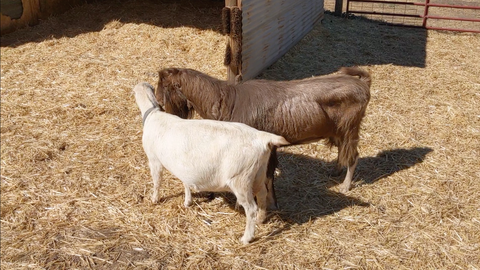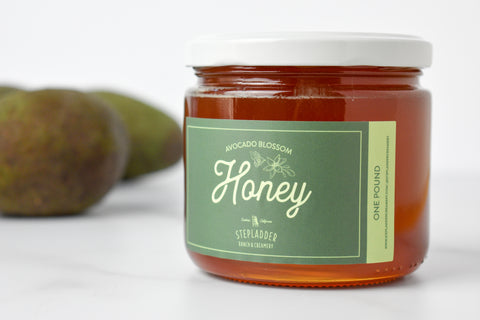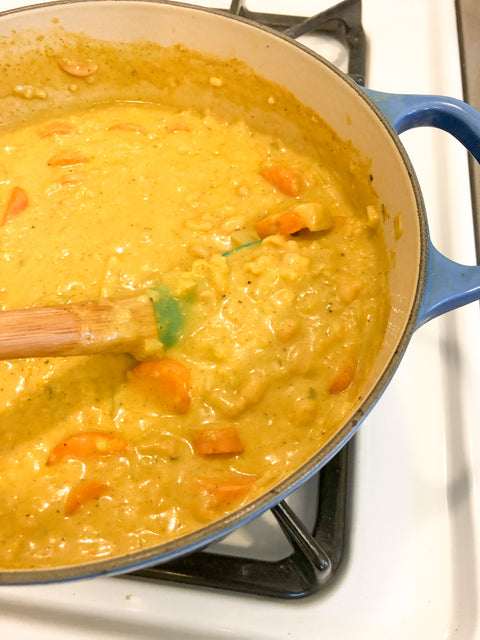Love is in the air - It's officially goat breeding season on the Stepladder Ranch & Creamery farm!
This is a very important time of the year for us, as it will dictate the success of next year’s birthing season and subsequent goat milking season. At Stepladder, we rely on good ole’ fashioned nature to work its magic on the ranch by bringing us a yearly hord of darling little goat kids as well as the milk that follows suit.
Continue reading to learn all about it, or watch our video on the goat breeding season here:
Breeding season in the goat world starts in fall and continues into early winter. It is evidenced by the behavior of our goats, which goes from generally docile and mild-mannered in Spring and Summer to cantankerous and volatile as Autumn approaches.
Even the most docile of our does will often be plunged into a frenzy of squabbling as they vie for the attention of the engrossed males, while the more domineering of our does becomes so belligerent that no other doe will even think of approaching her.

This riotous behavior is even more pronounced in the bucks. For about 9 months of every year these guys take solace in each other's company and are able to share their pasture, shelter, food, and even a fence line with the ladies. But this all changes in early September, when their natural hormone levels start to fluctuate and send them into a frenzy of activity.
At this point in the year, the males will generally eat very little and often lose quite a bit of weight as they tend to spend their time pacing along the fence line, calling to the does, and generally thinking about the one thing at the forefront of their minds. They also begin producing a very strong, musky odor that is rather unpleasant for their human handlers, but is irresistible to the does.

They can also get quite aggressive with each other, so at this point in the year we always separate each male and give him his very own bachelor pad in which he will get through the tempestuous breeding season.
This serves a double purpose of also allowing him to hold court with the ladies, who he will be paired up with in a one-on-one “goat date” based upon the genetic viability of the match. In other words, he will not be paired with sisters, cousins, nieces, or any other close relative.
Luckily for us, we have access to software that can actually calculate down to a minute fraction the amount of potential inbreeding in any prospective match between our goats based upon their lineage, which has been recorded through many generations in the America Dairy Goat Association Registry.

Once we have utilized this software to determine the pairings of each of our goats, we start to set aside some time for each pair to get together and work the magic of nature. The scheduling of each goat date is decided by the doe’s heat cycle, which runs on a 21 day time span.
For two to three days at the start of this cycle, the doe will be in heat and is receptive to the male. It is usually pretty obvious to the doe’s handlers when these days occur, as she will often wag her tail in his direction and generally find everything about the buck to be irresistible, from his strong, musky odor, to the leg stamping, spitting, grunting, and tongue wagging that define goat flirtation.
Once it is clear that a doe is in heat, it is up to the handler to make all the arrangements for the upcoming “goat date.” Luckily this is a rather simple task; rather than go through all the trouble of candlelit dinners and soft music, we simply lead the doe into the buck’s bachelor pad and let his masculine wiles do the rest of the work.

Once the deed is done (which generally takes just a couple minutes), the doe is removed from the buck’s pen and returned to the pasture with the other does. She will most likely get another date with the buck the next day and perhaps the day after that if she is still in heat, just to ensure a better chance of pregnancy.
If the pregnancy does not take, she will come back into heat in another three weeks and the process will be repeated. If she is pregnant, her gestation will last for about 5 months and she will deliver anywhere from 1-4 babies the following Spring.

While she is pregnant, she is basically on “maternity leave” and will not be milked through the winter months but instead will just relax in the pasture with her buddies and go on the occasional lazy walk into the hills to graze. This is the reason some of our cheeses are only available seasonally - we don’t always have goat milk with which to make our delectable goat cheese!
But, luckily once she has delivered her offspring, most of the milk will go to her young while a small amount will be kept to make our delicious goat cheese. We hope you can be patient through winter while our beautiful does grow next year's darling offspring, but in the meantime we will keep a steady supply of our delicious cow’s milk cheeses on hand for your enjoyment!




